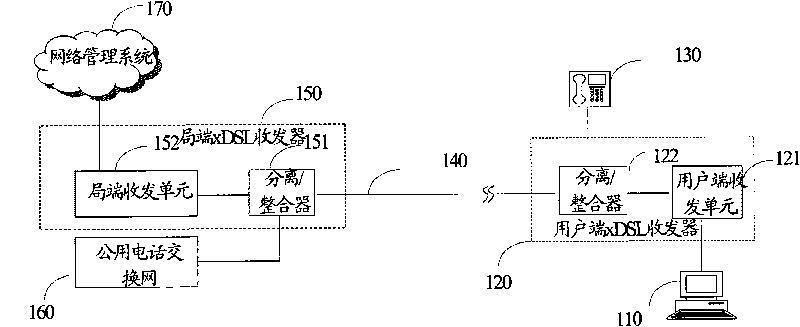Uplink power decreasing method, device and system in digital subscriber lines
A digital subscriber line and subscriber line technology, applied in line transmission parts, telephone communications, electrical components, etc., can solve the problems of operator inconvenience, inability to guarantee performance, and excessive short-line PSD reduction, to maximize gain and ensure Stability and the effect of enhancing potential demand
- Summary
- Abstract
- Description
- Claims
- Application Information
AI Technical Summary
Problems solved by technology
Method used
Image
Examples
Embodiment approach 1
[0059] Steps to collect user line information:
[0060] Collect subscriber line operation information, such as Hlog (subscriber line attenuation), QLN (static noise), b-table (bit allocation table), Profile (template), bandplan (spectrum planning), etc., topology information, such as subscriber line length and distribution ;
[0061] Steps to get the length of the reference line:
[0062] Subscriber lines are divided into multiple groups (such as G groups) according to the length of the subscriber lines, and the average line length of each group is calculated as the line length of the representative subscriber line (L g ), according to the number of user lines representing user groups (N total ), the weighted average of the representative user line is used to obtain the length of the reference line (L_ref), and the calculation formula is as follows:
[0063] L _ ref = Σ g = ...
Embodiment approach 2
[0077] Steps to collect user line information:
[0078] Collect subscriber line operation information, such as Hlog (subscriber line attenuation), QLN (static noise), b-table (bit allocation table), Profile (template), bandplan (spectrum planning), etc., topology information, such as subscriber line length and distribution ;
[0079] Steps to get the length of the reference line:
[0080] Start to traverse from the shortest line length to the longest line length at a certain step to search for the optimal reference line length. You can first select a length as the current reference line length;
[0081] Calculate the a and parameter b of each uplink frequency band of each pair of lines according to the length of the current reference line, and obtain the frequency point FMAX corresponding to the maximum subcarrier used by each subscriber line. This process can also be performed in the two ways described in Embodiment 1. to get.
[0082] Determine the maximum cut-off frequency...
Embodiment approach 3
[0097] Steps to collect user line information:
[0098] Collect subscriber line operation information, such as Hlog (subscriber line attenuation), QLN (static noise), b-table (bit allocation table), Profile (template), bandplan (spectrum planning), etc., topology information, such as subscriber line length and distribution ;
[0099] Steps to get the length of the reference line:
[0100] Select different reference line lengths for each frequency band, find the minimum value of all subscriber lines in the maximum usable frequency point of the frequency band according to bit loading, and take the length of the subscriber line corresponding to the minimum value as the length of the reference line;
[0101] Steps to obtain uplink power down-regulation parameters:
[0102] Calculate the parameter a and parameter b of each uplink frequency band of each pair of lines according to the reference line length of each frequency band, and calculate the usable frequency points of each fr...
PUM
 Login to View More
Login to View More Abstract
Description
Claims
Application Information
 Login to View More
Login to View More - R&D
- Intellectual Property
- Life Sciences
- Materials
- Tech Scout
- Unparalleled Data Quality
- Higher Quality Content
- 60% Fewer Hallucinations
Browse by: Latest US Patents, China's latest patents, Technical Efficacy Thesaurus, Application Domain, Technology Topic, Popular Technical Reports.
© 2025 PatSnap. All rights reserved.Legal|Privacy policy|Modern Slavery Act Transparency Statement|Sitemap|About US| Contact US: help@patsnap.com



